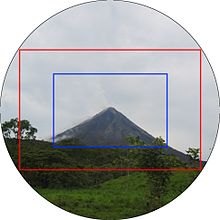
In digital photography, the crop factor, format factor, or focal length multiplier of an image sensor format is the ratio of the dimensions of a camera's imaging area compared to a reference format; most often, this term is applied to digital cameras, relative to 35 mm film format as a reference. In the case of digital cameras, the imaging device would be a digital image sensor. The most commonly used definition of crop factor is the ratio of a 35 mm frame's diagonal (43.3 mm) to the diagonal of the image sensor in question; that is, . Given the same 3:2 aspect ratio as 35mm's 36 mm × 24 mm area, this is equivalent to the ratio of heights or ratio of widths; the ratio of sensor areas is the square of the crop factor.
The crop factor is sometimes used to compare the field of view and image quality of different cameras with the same lens. The crop factor is sometimes referred to as the focal length multiplier ("Film") since multiplying a lens focal length by the crop factor gives the focal length of a lens that would yield the same field of view if used on the reference format. For example, a lens with a 50 mm focal length on an imaging area with a crop factor of 1.6 with respect to the reference format (usually 35 mm) will yield the same field of view that a lens with an 80 mm focal length will yield on the reference format. If it is desired to capture an image with the same field of view and image quality but different cameras, the aperture and ISO settings also need to be adjusted with respect to the crop factor.[1] The focal length of the lens does not change by using a smaller imaging area; the field of view is correspondingly smaller because a smaller area of the image circle cast by the lens is used by the smaller imaging area.
